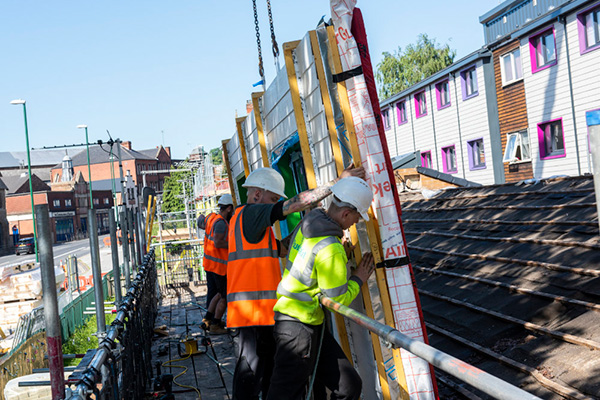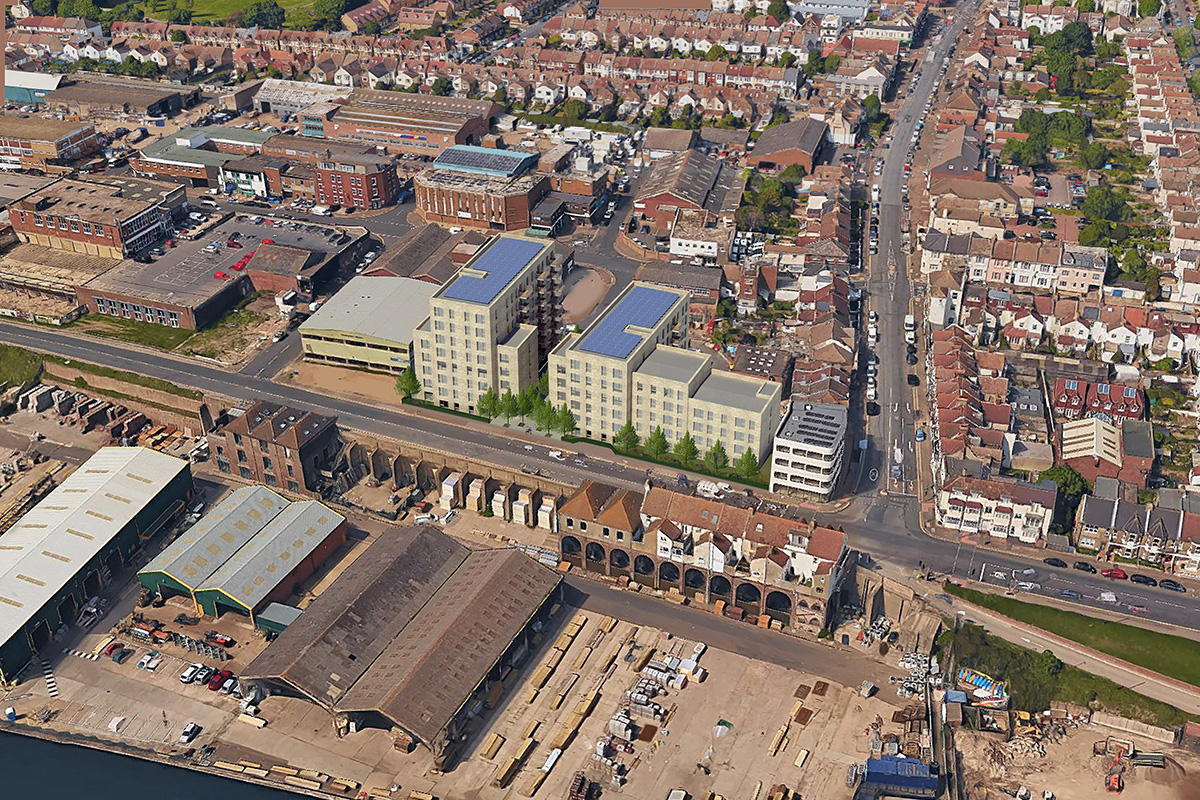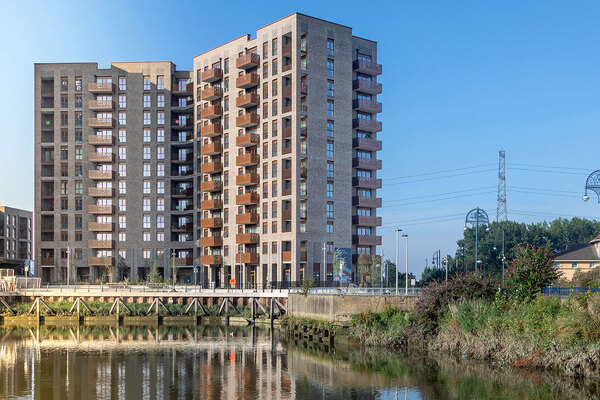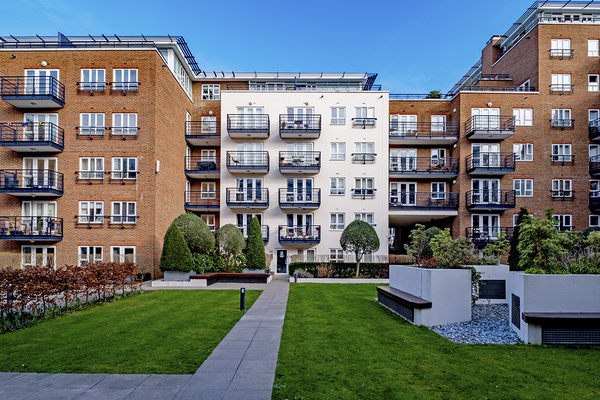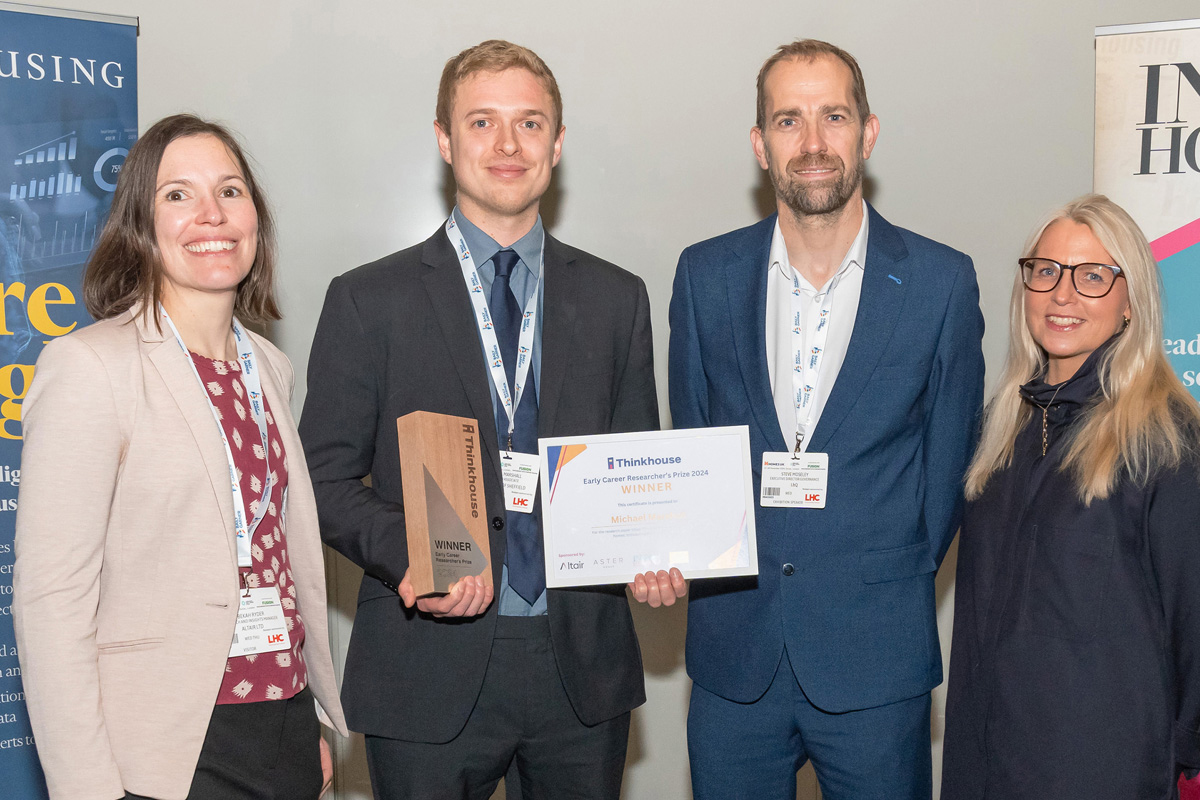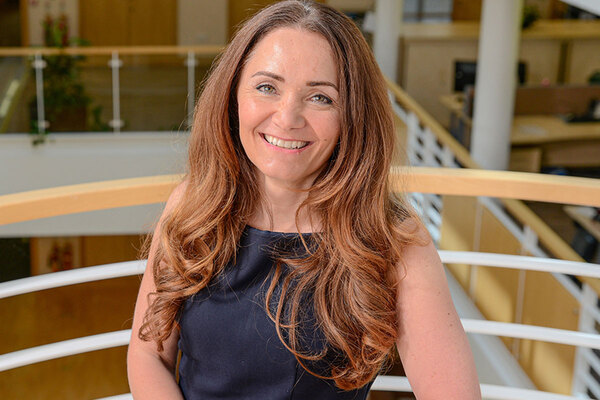The cost of net zero: social landlords’ decarbonisation plans revealed
How do landlords plan to achieve net zero and how much do they expect it to cost? Exclusive research by Inside Housing reveals what housing associations and councils are planning, and how much it will set them back. Lucie Heath reports. Illustration by Eliot Wyatt
There is a lot you could do with £104bn. You could pay the rent for all social housing tenants in England for five years. It is also enough to cover councils’ temporary accommodation bills for the next 84 years, if costs were to remain roughly the same as today.
Inside Housing estimates that £104bn is also how much it could cost to decarbonise the UK’s social housing stock, based on the average decarbonisation cost per property provided to us. A total of 207 social landlords across all four nations responded to our request for information about their decarbonisation plans and how much they expect to spend – including 152 stock-holding councils, 54 housing associations and the Northern Ireland Housing Executive.
“The UK’s legally binding climate change targets will not be met without the near-complete elimination of greenhouse gas emissions from UK buildings”
These plans varied greatly in both detail and ambition. While some landlords are aiming for their stock to become carbon neutral within the next 10 years, others are yet to set any meaningful targets. Projected costs ranged from just over £2,500 per property to an eye-watering £40,000-£50,000 per home. Replicated across the roughly five million social homes in the UK, that would put the total cost anywhere between £12.5bn and £250bn at the most expensive.
We have opted to present the figure of £104bn as an indicator for the sector, which is calculated by multiplying by five million the average (mean) per property figure provided to us by landlords (£20,742).
While there is no denying £104bn is a huge amount of money, the sector cannot afford to hide from the task. With the UK government’s carbon-neutral target only 30 years away, landlords have hit the point where the cost of net zero should be factored in to their long-term business plans. Under legislation passed in 2019, the UK is legally obliged to reach net-zero carbon emissions by 2050. Although specific legal targets for the social housing sector have not been set across the whole of the UK, energy use in UK homes accounts for 14% of the nation’s emissions. A report by the Climate Change Committee concluded that “the UK’s legally binding climate change targets will not be met without the near-complete elimination of greenhouse gas emissions from UK buildings”. The clear implication is that emissions from social housing will have to be drastically slashed.
Inside Housing digs into the figures to find out what the sector is hoping to achieve, how it is planning to get there and how much it is going to cost them.
In numbers
£104bn
Potential cost of decarbonising the UK’s social housing stock
64%
Proportion of Welsh councils that are already working towards a 2030 net-zero target
20.8%
Percentage of landlords aiming to achieve net zero at an earlier date than that set by their government
70.1
Average SAP rating of survey respondents
4%
Proportion of £104bn potential cost of decarbonisation that the £3.8bn decarbonisation fund will cover
What is the current condition of the sector’s stock?
Of the 207 social landlords that responded to Inside Housing’s survey, 167 (81%) were able to provide the average standard assessment procedure (SAP) rating of their housing stock.
Based on a scale of one to 100, a SAP rating is the main unit of measurement used by the government to assess and compare the energy performance of homes. A rating of 100 would effectively have a cost of £0 for heating, hot water and lighting. A home could score higher than 100 if it is a net exporter of renewable energy to the grid.
The average SAP rating of all respondents was 70.1. At 61.23, Bolsover District Council had the worst average rating, while Folkestone & Hythe District Council topped the table with an average SAP rating of 84.
To put this into context, the latest English Housing Survey, which is commissioned annually by the government, found that in 2018 the average SAP rating for all housing stock in England was 63. This suggests that social landlords are in a much better position than private landlords when it comes to meeting decarbonisation targets and reflects the level of energy efficiency work already carried out by the social housing sector.
What is the deadline for zero carbon?
Many social landlords have their eyes set on 2050, when the UK government has said the country will achieve net-zero carbon emissions.
In the more immediate future, the UK government has said that all social housing should be upgraded to a minimum of Energy Performance Certificate (EPC) band C, which equates to a SAP score of between 69 and 80, by 2030. In Scotland, the government has set a more ambitious national net-zero target of 2045. The Scottish government has also set a target that landlords must maximise the number of homes with an EPC band B (SAP 81-91) or higher by 2032.
“I think in most cases people have looked at 2050 as a more realistic timescale and 2030 is something that is just going to be virtually impossible to achieve”
While the Welsh government has yet to finalise decarbonisation targets for social housing, it is expected to set a target of 2030. Of the 11 Welsh councils that responded to Inside Housing’s survey, seven (64%) said they were already working towards a 2030 target.
The Northern Ireland Executive has not set any decarbonisation targets in addition to those set by the UK government.
A total of 43 (20.8%) of the landlords surveyed by Inside Housing are aiming to achieve net zero at an earlier date than that set by their national government. These targets were mostly set by councils and included 31 local authorities that are aiming to achieve net zero by 2030. For some, this 2030 target has been set for the local authority area as a whole, while others set the target for the council as an organisation, including its housing stock.
Not everyone believes that tougher targets, or trying to reach the goal faster, is a good idea. Nicholas Doyle, director of sustainability consultancy Adecoe, believes it would be more useful if the sector worked together to the 2050 target, allowing landlords to reap the benefits of shared learning and a more developed supply chain. “This is not a race to the moon,” he adds.
John Kiely, director of housing and public sector at Savills, agrees. “There’s a huge extra challenge in getting to zero carbon by 2030, compared to 2050,” he says. “I think in most cases people have looked at 2050 as a more realistic timescale and 2030 is something that is just going to be virtually impossible to achieve, but they’re looking at a way of perhaps how they could make the best endeavours to get there by that date.”
Linda Hobson, cabinet member for housing at Newcastle City Council, which is aiming to make Newcastle a carbon-neutral city by 2030, acknowledges that the target is “challenging” but says that “the commitment is absolutely there” from both the council and Your Homes Newcastle, the ALMO responsible for managing the council’s stock.
While operating within local authority areas with tighter targets definitely creates new challenges for housing associations, Diana Lock, head of energy and environment at Optivo, says the landlord has been able to reap the benefits by working in collaboration with these councils. For example, Optivo recently won some funding in partnership with Hastings Council and East Sussex County Council through the government’s Green Homes Grant scheme, which they are using to do pilot work around achieving EPC band B.
Case study: Hyde Group
A CGI of a Hyde development in Portslade (not yet under construction) showing solar panels on buildings’ roofs
The Hyde Group, which owns roughly 50,000 homes across London and the South East, has set a target to achieve EPC band C by 2030 and is currently developing a net-zero carbon roadmap that identifies four potential net-zero emissions scenarios to reach this target.
The four scenarios are investing for all homes to reach EPC band C, EPC band B, EPC band A, and a low carbon option, which applies all possible low-carbon measures from its energy investment model for comparison with the other targets. This is based on data taken from building condition surveys and EPCs from 93% of the homes affected.
“We’ve done a full survey on our existing homes”
Neal Ackcral, chief property officer at Hyde, says the organisation believes it will cost somewhere around £17,000 for each of Hyde’s homes to achieve band B by 2050. Around two-thirds of that cost is currently included in Hyde’s stock investment programmes.
“I’d say we’re in a fairly good position,” Mr Ackral says. “We’ve done a full survey on our existing homes and also what we want to do around new build first of all.”
He continues: “What we very clearly identified early on is if we wanted to, we could just offset a load of carbon and we could probably meet the targets. Clearly we didn’t want to do that because we recognised the social value from affordable warmth and everything else that looking at our properties in a proper way and doing some changes would give us.”
Hyde has set a standard that all new builds will be built to a minimum of EPC band B, with the ambition to “go a lot further than that”. In terms of existing homes, Hyde’s approach is “going fabric first, then carbon reduction for heating and power, and then third is going to be renewable”.
What does zero carbon mean for social landlords?
One stark finding from Inside Housing’s survey was that the majority of landlords, including those who have set ambitious 2030 targets, were unable to provide a definition of what zero carbon would look like in their housing stock.
A total of 44 landlords (21%) provided some type of definition for what net zero means to them as an organisation, however many of these definitions were vague. Of the 31 local authorities aiming to hit net zero by 2030, 21 (a startling 68%) were unable to define what net zero means for their housing stock.
For those which were able to provide a precise definition, the answers varied greatly. Some landlords are targeting an average SAP rating, however there is little agreement over what this SAP rating should be. For example, Trafford Housing Trust and Karbon Homes are aiming for an average SAP of 99, while Cornwall Council and Optivo are aiming for an average SAP of 87, with Optivo caveating that this is based on the assumption that the national grid will be decarbonised by 2050. Exeter Council, on the other hand, is potentially looking to define net zero as a 90% reduction in carbon emissions on the council’s 1990 carbon baseline. Crawley Council is defining net zero as a reduction of energy use to 50kWh per square metre.
“You don’t want to come back to a property X number of times. You want to have a holistic view of what all the measures are that we need to implement here over the next 30 years”
Many agree that a sector-wide definition of net zero would be useful for social housing. Richard Lupo, managing director of Suss Housing, which runs the SHIFT environmental accreditation for social landlords, said a definition of net zero is something the sector should “keep nagging government for every month”.
However, the sector should not wait for clarity from government. Karin Stockerl, director of asset strategy and services at Optivo, says setting a target of SAP 87 has allowed the organisation to “think ahead” to 2050.
“You need to think about that because we constantly have investment programmes and you don’t want to come back to a property X number of times. You want to have a holistic view of what all the measures are that we need to implement here over the next 30 years,” she says.
How much is it all going to cost?
A total of 46 (22%) of the landlords that responded to Inside Housing’s survey were able to provide some kind of estimate of how much it would cost to get to net zero within their housing stock.
The majority of landlords that provided us with costs were able to give the total estimated decarbonisation cost for their housing stock. For those who did, we calculated the average cost per property by dividing this cost by the entire number of homes they own. For those that provided us only with an average cost per property, we used this number instead. If landlords provided us with a range, we used the middle number as an average figure.
Again, these cost estimates varied greatly in detail, with some landlords providing figures based on the results of sector-wide studies, while others had undertaken a more detailed cost-modelling exercise against their own stock.
At £2,842 per home, Optivo provided the lowest cost per property figure, with the explanation that this did not include costs such as replacing gas heating with electric, as well as roof and window upgrades, as these are covered in other budget lines.
The highest cost was provided by North West Leicestershire Council, which said it estimated it would cost “up to £50,000 per unit” for a comprehensive retrofit of its 4,200 properties and therefore provided a total cost of £210m. This was followed by Cardiff City Council, which estimated that retrofitting would cost £40,000 per unit. When multiplied by the council’s 13,674 homes this equates to a total cost of £550m.
The mean cost per property across all respondents was £20,742. When multiplied across the roughly five million social homes in the UK, that brings the total cost for the sector to £104bn.
Unsurprisingly, those with the largest stock profile also faced the largest total decarbonisation costs. With 85,162 homes, the Northern Ireland Housing Executive was the largest landlord that was able to provide us with cost estimates. It provided a total cost of £1.7bn, which equates to roughly £20,000 per home. This was followed by 58,539-home Sovereign, which estimates it will cost £860m for it to meet its targets, which equates to just under £15,000 per home.
“We’ve had costs vary by almost 100% between different associations, depending entirely upon what they’ve got in their business plans at the moment, what their stock looks like and how much work they’ve done in the past”
There are a huge variety of factors that could influence how much it will eventually cost for landlords to retrofit their entire stock to zero-carbon standards. The age and composition of stock is an obvious one, with old solid wall homes and high rises just two examples of stock types that are viewed as particularly challenging.
Landlords’ existing maintenance plans, and how they factor that in to their cost estimate, is another important factor.
“We’ve had costs vary by almost 100% between different associations, depending entirely upon what they’ve got in their business plans at the moment, what their stock looks like and how much work they’ve done in the past,” says Savills’ Mr Kiely, who has worked with more than 30 landlords to develop cost estimates.
The cost of technology is another important factor. As Mr Lupo puts it: “Who knows what the price of a heat pump will be in 15 years?”
Given that the cost of solar panels dropped 82% between 2010 and 2019, and landlords across the country will be implementing work at a huge scale, this is an important caveat.
Yet despite the uncertainty and variation, it is vital that social landlords start developing their own decarbonisation cost estimates against their housing stock. The urgency for this has been compounded as a result of the building safety crisis, which will also see the sector spend billions on upgrading their existing homes.
The economic value of retrofitting
According to new research by IPPR North, in partnership with the Northern Housing Consortium, retrofitting homes in the North of England could create 77,000 new jobs in the region, as well as a further 111,000 supply chain jobs across the UK, by 2035.
In alignment with the government’s ‘levelling-up’ agenda, the research also found that retrofitting could bring a £3.85bn gross value added (GVA) boost each year for the North, alongside a £5.61bn GVA boost each year in supply chains across the UK. IPPR North is calling for all 1.27 million social homes in the North to be retrofitted within the next decade as part of a £2.36bn a year programme, of which at least half must be funded by government grants. Currently 1.35 million homes in the North fail to meet decent homes standards, while roughly 731,500 households (one in 10) are living in fuel poverty.
“Sixty-four councils and combined authorities in the North have declared a climate emergency, but the nation isn’t doing enough to meet our emissions commitments… Decarbonisation isn’t an option – it’s vital for our region, our country and our planet,” says Marcus Johns, research fellow at IPPR North.
How is the sector going to pay for this?
As the sector grapples with building safety and attempts to rise to the challenge of alleviating the housing crisis by building more affordable homes, social landlords can be forgiven for wondering how on earth they are supposed to pay for this.
"A 10-year £3.8bn decarbonisation fund was promised as part of the Conservative Party’s 2019 manifesto – this represents only 4% of our £104bn indicator"
Many will be looking to the government to provide long-term funding for sustainability work, ideally in the form of grants. While there is no doubt that more government funding will become available – a 10-year £3.8bn decarbonisation fund was promised as part of the Conservative Party’s 2019 manifesto – this represents only 4% of our £104bn indicator.
There are also some things social landlords can do now in a bid to reduce that overall figure. Mr Lupo believes that all new build social housing should be built to a standard of EPC A, arguing that this will save landlords “an awful lot of money in the future”.
He says landlords should also make a long-term, whole-house plan for each of their homes, which will allow them to choose cost-effective times to upgrade, for example by installing solar and roof insulation at the same time as undertaking a planned roof replacement.
Inside Housing’s survey has shown that the majority of social landlords are yet to develop detailed zero-carbon plans that are specific to their housing stock.
In some ways it is hard to blame them for this: planning has become incredibly difficult for the sector since it has been hit with the double whammy of building safety and COVID-19.
However, those that are already looking ahead to 2050 are likely to reap the benefits over the next 30 years. If landlords start planning more now, that £104bn will start looking a lot less scary.


